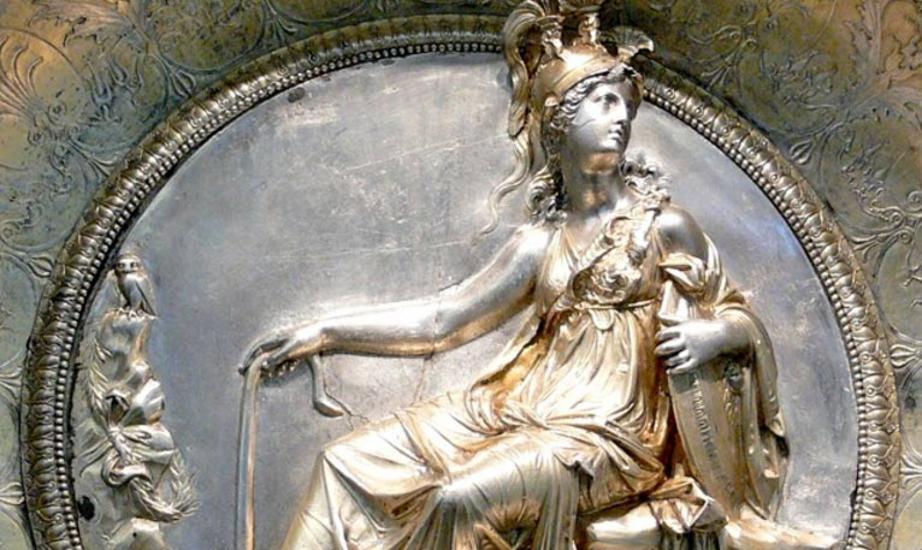The hidden identity of the woman glorified as Athena: her link to the pre-flood world
Here is that woman in all her splendor, reconstructed in the imitation Parthenon in Nashville, Tennessee, based on the original in her ancient temple atop Athens’ Acropolis—the high place of the city. Athena is a title or epithet. We’ll find out her real human name as we continue.
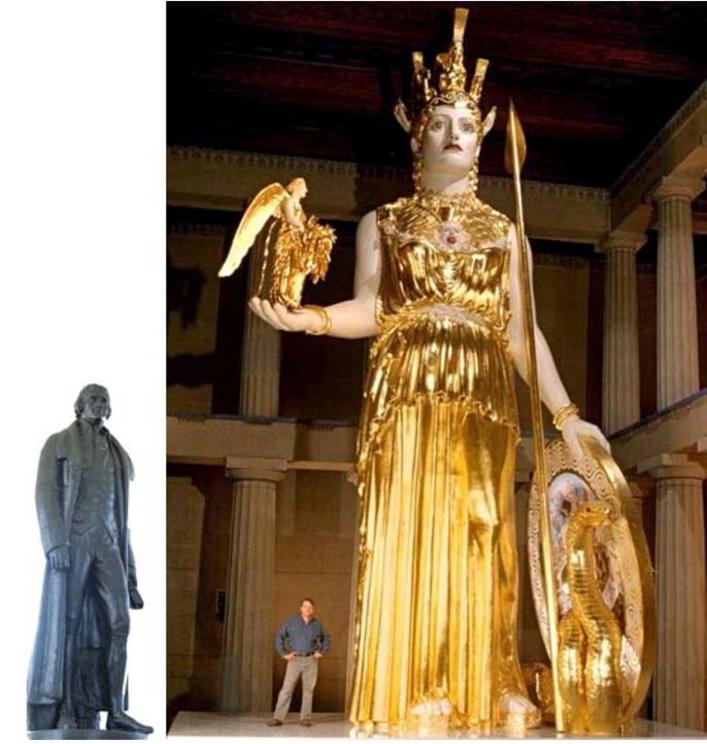
Bronze statue of Thomas Jefferson from his memorial in Washington, DC compared with Athena's imitation gold and ivory idol-image in Nashville, Tennessee, with the man responsible for the reconstruction, Alan LeQuire, standing next to her.
Alan LeQuire, who reconstructed her idol-image, stands beside her, giving us an idea of the immense adoration the ancient Greeks had for this woman. But why?
I’ve placed a proportional image of Thomas Jefferson from his Washington, DC memorial next to her for comparison of their relative importance. As great as Jefferson was, his statue pales in stature next to the 40-foot-tall Athena. She is more than twice his size.
Jefferson’s statue is made of bronze; Athena’s, of ivory and gold fashioned around a wooden core.
We honor Jefferson as the man who led the American colonies in declaring independence from the British Crown. The ancients adored Athena as the woman who, after the Flood, led most of mankind in declaring their independence from the authority of Noah and his God.
There is no Creator in the Greek religious system—only deified ancestors who welcome the serpent’s “enlightenment.” On the idol-image, inside Athena’s protective shield, the Genesis serpent rises up next to her. In her right hand she holds, Nike, or Victory. The meaning is self-evident to me: This is the woman whose friendship with the serpent has led to mankind’s victory over Noah and his God-fearing offspring.
Greek sculptors and artists consistently identified Athena with the serpent. From her pre-Parthenon temple, her idol-image, below, grasps the serpent that trims her aegis, a symbol of authority, and she wears a crown of serpents—she has the mind of the serpent. On the vase painting from about 500 BC, she wears her serpent-trimmed aegis as she appears to be getting instructions from the serpent.
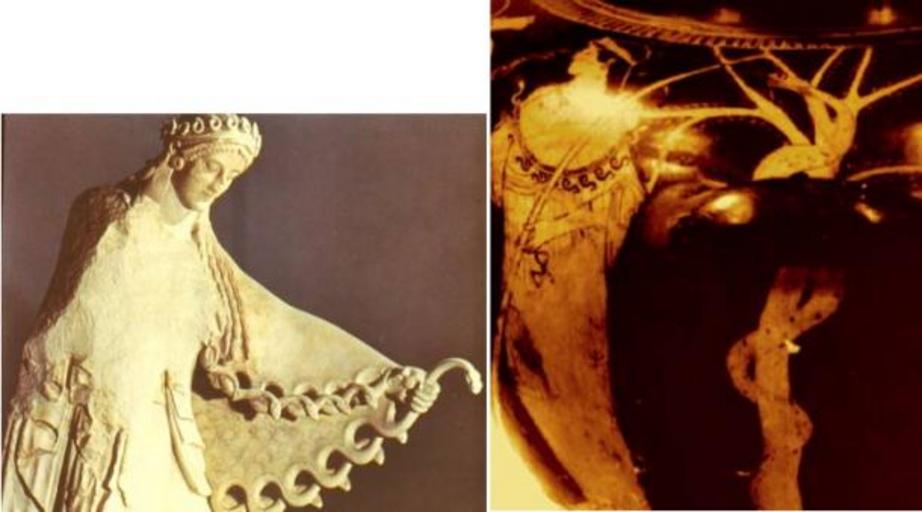
Left, on Athena's pre-Parthenon idol image from about 450 BC, she wears a crown of serpents and grasps the serpent that trims her aegis - her cloak of authority. Right, on a vase from the same period, Athena stands as if receiving instructions from the serpent. The vase handle blocks part of the serpent and tree.
The Ancestors Who Put the Greek Religious System “in Place”
How can we be sure she was a real woman? The answer to that is self-evident as well: The Greek gods look and act exactly like real people because they were real people.
In Plato’s Dialogue, Euthydemus (at 302d), Sokrates referred to Zeus, Apollo, and Athena as his “lords and ancestors.”
Saint Augustine understood as well that the gods were but glorified ancestors (City of God, VIII. 26).
According to the Greeks, Herakles accomplished many feats as a man here on earth. Upon his death, Nike transported him in her chariot to join his ancestors on Mount Olympus.
The Greek word for gods is theoi, meaning literally “placers.” The Greek gods, almost exclusively, are the ancestors in the way of Cain who put the God-shunning, serpent-welcoming, and mankind-exalting Greek religious system “in place.”
We build grand monuments to our own accomplished ancestors. They look like temples because they are temples. Inside the Lincoln Memorial, we read, “In this temple, as in the hearts of the people for whom he saved the union, the memory of Abraham Lincoln is enshrined forever.”
Inside Athena’s ancient temple, her idol-image undoubtedly evoked a similar sentiment, something akin to this: “In this temple, as in the hearts of the people for whom she brought back the way of Cain and the serpent’s enlightenment after the Flood, the memory of this adored woman we call Athena, is enshrined forever.”
We learn from Acts 17:23 that Paul stood on the Areopagus (the hill of Ares) in Athens, and read on the pedestal there: "To the Unknown God." Next to where Paul stood, towered the Acropolis—the precinct of the way of Cain with Athena's temple and her idol image on its summit. She is the reason that God was unknown to the Greeks and to most of the rest of humanity as well.
In the oldest written Greek known as Linear B, she was Athana, short for Athanatos, meaning the deathless or immortal one.
As I point out in my new full-color book, Genesis Characters and Events in Ancient Greek Art, Athana seemed immortal in the post-Flood world because she had come through the Flood, bringing the long pre-Flood life span possessed by Noah and his sons and their wives. She was, in fact, one of those wives—Naamah is her name, the conniving wife of Noah’s son Ham.
The Marriage of Ham/Chiron and Naamah/Chariklo
She is the last person mentioned in the line of Cain: “And the sister of Tubal-Cain is Naamah” (Genesis 4:22). She was the daughter of Lamech, the last ruler of the Cainites before the Flood. Greek artists depicted the courtship and marriage of Ham and Naamah on several ancient vases under their Greek names Chiron and Chariklo.
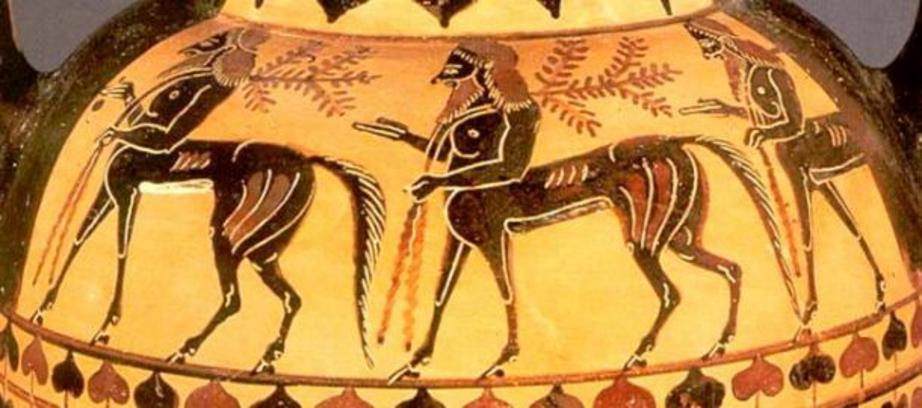
On a vase from about 500 BC, three Centaurs walk in line, two of them carrying a branch signifying they belong to a different branch of humanity - the line of Seth as opposed to the supposedly culturally and intellectually superior line of Cain.
Ham/Chiron was one of the men in the line of Seth. Greek artists depicted Seth-men as Centaurs, half-men, half-horses, almost always showing them bare-chested, often carrying a branch, as above, indicating that they belonged to an inferior branch of humanity, as opposed to the supposedly superior, cultured, man-elevating line of Cain.
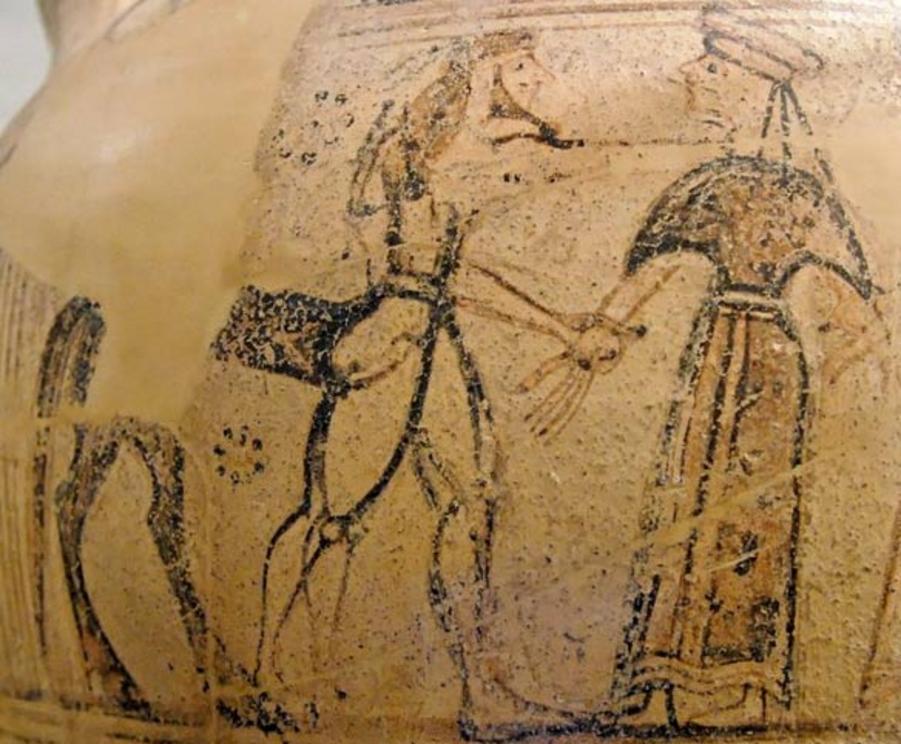
On a vase from about 600 BC, Ham/Chiron grasps the wrist of Naamah/Chariklo, a sign in ancient Greek art that she is to be his bride.
The artists made a special exception for the Seth-man, Ham/Chiron, depicting him with the full front of a man because to them he was the “good” Centaur, who brought the Cainite princess, Naamah/Chariklo, through the Flood as his wife. In the above vase-depiction from about 600 BC, Ham/Chiron takes the wrist of Naamah/Chariklo, a sign in Greek art that she is to be his bride.
Naamah’s great-grandfather had the name Mehujael (Genesis 4:18) meaning “Wipe out God.” That’s the mindset Naamah brought with her through the Flood as Ham’s wife. There is no doubt in my mind that she is the one responsible for Ham’s mocking attitude toward his father Noah, related in Genesis 9:20-27. Naamah/Athena inspired and directed the resurgence of the way of Cain in the post-Flood world through her son Cush/Hermes and her grandson Nimrod/Herakles, and was exalted for that reason.
After the tower of Babel, mankind adored Naamah by many titles including: Lama, Astarte, Ishtar, Hathor, Isis, Maat, Artemis, Inanna, Asherah, and ultimately in her most glorious idolization as the great Greek goddess Athena.
Confirmation from Secular Scholars
A most revealing 782-page book by secular scholars Anne Baring and Jules Cashford, titled The Myth of the Goddess, supplies confirming evidence. The authors trace the goddesses of the ancient Near-eastern and Mediterranean world back to a single figure, the Sumerian Nammu—a minor linguistic variation of Naamah. Below, we see an ancient Sumerian image of Naamah/Nammu. She wears a mountain hat representing the mountain from which she descended after the Flood. In her hand, she holds the double-headed serpent symbolizing the serpent’s rule in the pre-Flood world, and now in the post-Flood world as well.
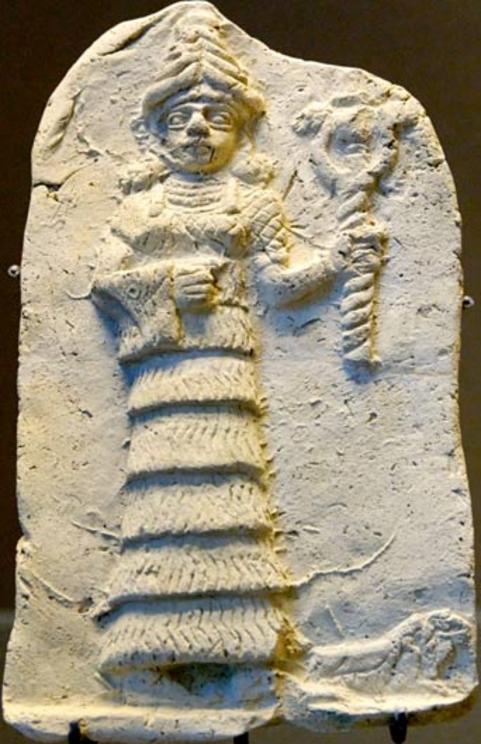
The Sumerian Nammu, depicted with her mountain hat representing the mountain from which she descended after the Flood, and holding the double-headed serpent symbolizing the serpent's rule in the pre-Flood world, and now in the post-Flood world as well.
Many of the significant ancient goddesses were linked to the Flood in some way, beginning with the one they represented, Naamah/Nammu.
Baring and Cashford: “The images of water and sea, the unfathomable abyss of the Deep, return us to Nammu, the Sumerian goddess whose ideogram was the sea . . . Asherah [a Canaanite goddess] was called ‘the Lady of the Sea,’ which links her to the Sumerian Nammu, and to the Egyptian Isis, ‘born in all wetness.’” Those descriptions of the great Cainite woman who became worshipped as a goddess evoke the memory of the Flood, and her passage through it.
According to Baring and Cashford, in both the Babylonian and Sumerian stories, Inanna and Ishtar, derivative goddesses of the woman, Naamah/Nammu, lament the destruction of their people in the Flood.
The title of Baring and Cashford’s book ought to be “The Memory of the Adored Woman,” but as academic disciples of atheist mythologist Joseph Campbell, they failed to make the obvious Genesis connection, a connection absolutely critical to understanding human history.
After the Flood, Noah’s authority held sway for a time. Then, the adoration of the Cainite woman sprang up suddenly throughout the ancient world, and several generations later, most of humanity was “without God in the world” (Ephesians 2:12). God had let “all the nations go their own ways” (Acts 14:16).
“Ye Shall Be as Gods”
Ancient Greek religious art, with Naamah/Athena as the key inspirational figure, chronicles that foundational period of the “present evil age” (Galations 1:4)—boasting of humanity’s independence from our Creator, welcoming the serpent’s “enlightenment,” and exalting man as the measure of all things.
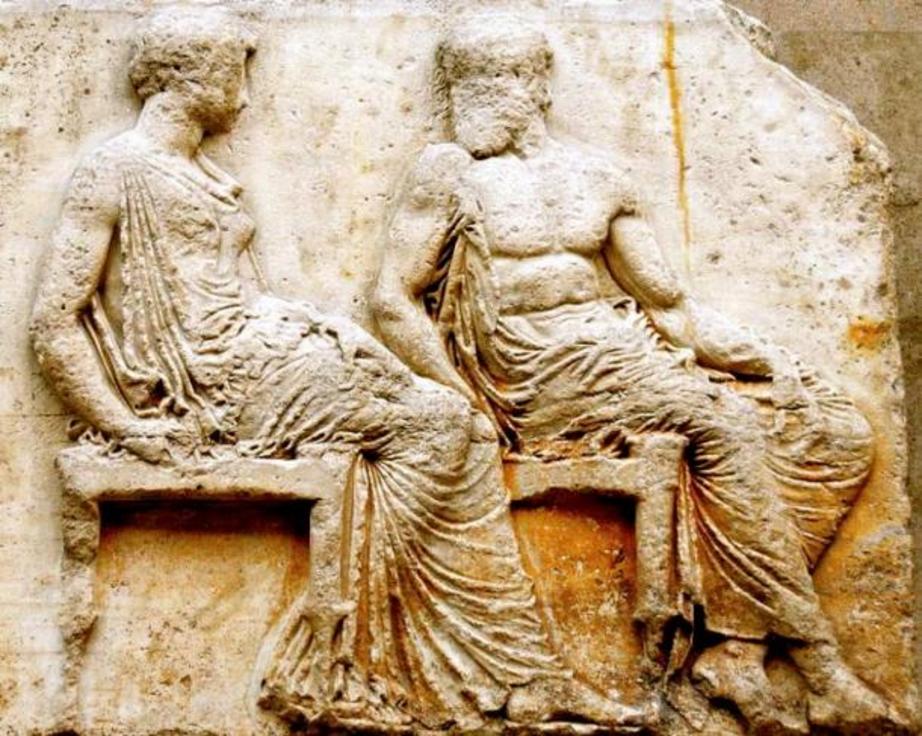
From about 430 BC, Naamah/Athena and Cain/Hephaistos are depicted chatting amiably on the east frieze of the Parthenon in Athens.
Above, from the east frieze of the Parthenon from about 430 BC, sculptors depicted Athena and Hephaistos (Zeus’ and Hera’s eldest son – the Greek counterpart of Cain) chatting amiably without their usual attributes. For Athena: no helmet, no spear, no serpent-trimmed aegis, no head of the Gorgon Medusa on her chest. For Hephaistos: no tongs, no hammer, no axe. The sculptors depicted them as who they knew them to be: their ancestors Naamah and Cain whose anti-God, mankind-exalting religious outlook they wholeheartedly embraced.
Below, on a vase from the same period, Herakles joins his ancestors on Olympus as an immortal. Left to right: Cush/Hermes, Eve/Hera, Adam/Zeus, Naamah/Athena, Nimrod/Herakles. Nike in the center proclaims the immortality of these ancestors as the greatest of victories.
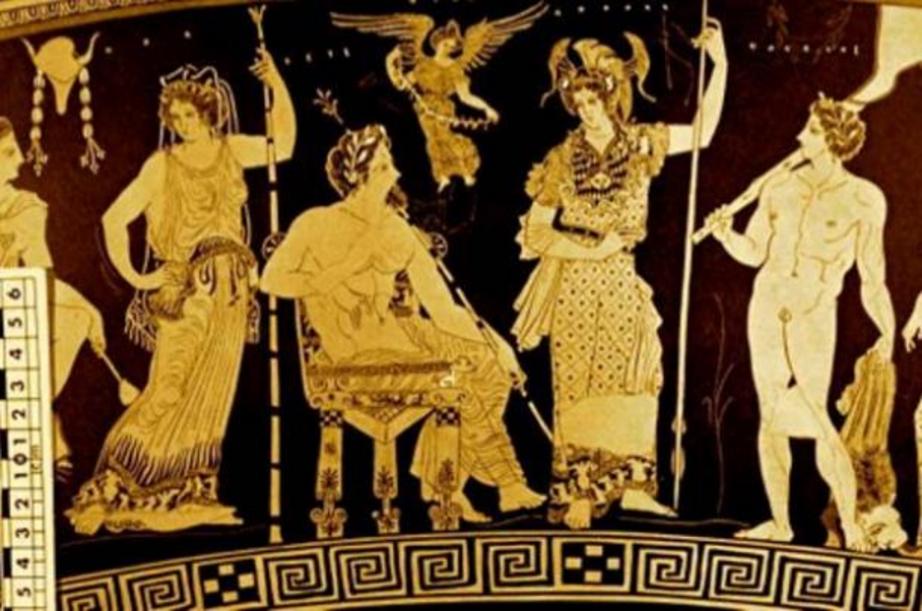
On a vase from about 430 BC, Nimrod/Herakles joins his immortal ancestors Naamah/Athena, Adam/Zeus, Eve/Hera, and Cush/Hermes on Mount Olympus.
Could it be any more obvious that these sculpted and vase figures are deified humans? In the ancient garden, the serpent promised, “Ye shall be as gods,” and as the ancient Greek artists have communicated so plainly to us, our elite ancestors who embraced its words, and its “enlightenment” did indeed become “as gods.”

